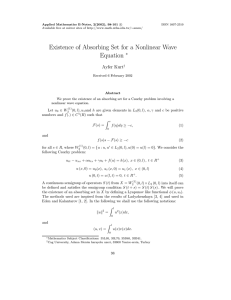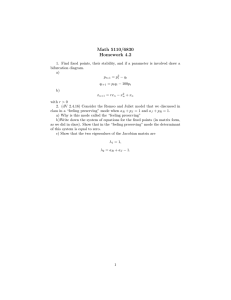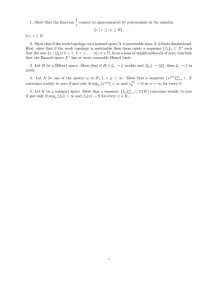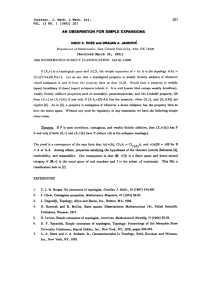Splitting noncommutative dynamical systems in almost periodic and
advertisement
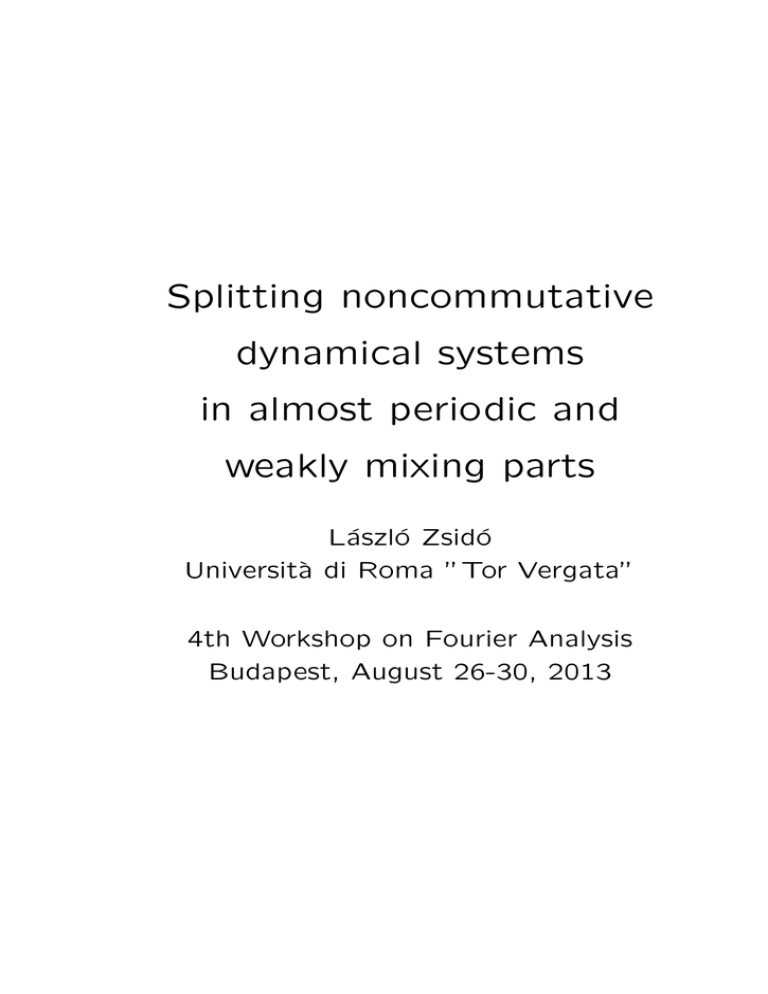
Splitting noncommutative
dynamical systems
in almost periodic and
weakly mixing parts
László Zsidó
Università di Roma ”Tor Vergata”
4th Workshop on Fourier Analysis
Budapest, August 26-30, 2013
State preserving C ∗-dynamical systems
Let us denote for a C ∗-algebra A by End (A)
the semigroup of all ∗-endomorphisms of A
and by Aut (A) the group of all ∗-automorphisms
of A .
A state preserving C ∗-dynamical system is a
quadruple (A , S , α , ϕ) consisting of a C ∗-algebra
A , a semigroup S , a semigroup-homomorphism
α : S 3 s 7−→ αs ∈ End (A) ,
and a state ϕ of A , such that the invariance
condition
ϕ ◦ αs = ϕ ,
s∈S.
is satisfied. We shall always assume that S
is unital and α maps the unit of S into the
identity automorphism of A .
If A is a W ∗-algebra, the ∗-endomorphisms αs
are normal and ϕ is normal state, then we call
(A , S , α , ϕ) a state preserving W ∗-dynamical
system.
Let (A , S , α , ϕ) be a state preserving C ∗-dynamical system and let us consider the GNSrepresentation
πϕ : A −→ B(Hϕ)
of ϕ with canonical cyclic vector ξϕ . Then
Usπϕ(x)ξϕ = πϕ αs(x) ξϕ ,
x∈A
defines a linear isometry Us : Hϕ −→ Hϕ and
S 3 s 7−→ Us
is a representation of S by linear isometries on
Hϕ satisfying
Usπϕ(a) = πϕ αs(a) Us ,
and
U s ξϕ = ξϕ ,
s∈S.
s∈S
If S is a group then every αs is a ∗-automorphism,
S 3 s 7−→ Us is a unitary representation and,
for every s ∈ S and a ∈ A ,
πϕ αs(a) = Usπϕ(a)Us∗ = Ad (Us)πϕ(a) . (1)
Therefore, denoting by M the von Neumann
algebra πϕ(A)00 ⊂ B(Hϕ) and by ωξϕ the vector
state
M 3 T 7−→ (T ξϕ|ξϕ) ,
we can define a state preserving W ∗-dynamical
system (M , S , β , ωξϕ ) by putting
βs = Ad (Us) ,
s∈S.
According to (1), the GNS-representation πϕ
yields a natural imbedding of the original C ∗dynamical system (A , S , α , ϕ) in the W ∗-dynamical system (M , S , β , ωξϕ ) .
If S is not a group, it can happen that for
some a ∈ A and s ∈ S we have πϕ(a) = 0 but
πϕ αs(a) 6= 0 , so cannot exist state preserving W ∗-dynamical system (M , S , β , ωξϕ ) satisfying
πϕ αs(a) = βs πϕ(a)
and therefore we cannot imbed (A , S , α , ϕ) in
a W ∗-dynamical system (M , S , β , ωξϕ ) with an
appropriate action β .
Nevertheless, if the support projection of ϕ in
the second dual A∗∗ belongs to the centre of
A∗∗ , what means that the cyclic vector ξϕ is
also separating for πϕ(A)00, then for arbitrary
S we have a (uniquely defined) state preserving W ∗-dynamical system (M , S , β , ωξϕ ) satisfying
πϕ αs(a) = βs πϕ(a)
for all s ∈ S and a ∈ A . This happens, for
example, if ϕ is a trace.
Moreover, if S is a topological semigroup and
the two-point functions
S 3 s 7−→ ϕ y αs(x) ,
x,y ∈ A
are continuous, then the isometry semigroup
S 3 s 7−→ Us
is continuous with respect to the weak operator topology, hence also with respect to the
strong operator topology. It follows that the
orbits
S 3 s 7−→ βs(T ) ,
T ∈M
are continuous with respect to the strong operator topology.
Almost periodicity and weakly mixing
Let M ⊂ B(H) be a von Neumann algebra
having a cyclic and separating vector ξo of unit
lenght, S a locally compact unital semigroup
and
α : S 3 s 7−→ αs
a unital semigroup homomorphism of S in the
semigroup of all normal ∗-endomorphisms of
M , which is continuous with respect to the
pointwise strong operator topology and which
leaves invariant ωξo :
ωξo ◦ αs = ωξo ,
s∈S.
We define the strongly continuous isometry
semigroup
S 3 s 7−→ Us
by
Us xξo = αs(x)ξo ,
x∈M.
We say that the dynamical system (M , S , α , ωξo )
is almost periodic if all orbits
{Us ξ ; s ∈ S} ⊂ H ,
ξ∈H
are relatively norm-compact and we say that
it is weakly mixing (to 0) if {0} ⊂ H is the
only relatively norm-compact orbit of U .
Weakly mixing is usually described by some
equivalent convergence property. For example, in the case of the additive semigroup
S = N of all integers n ≥ 0 , by a classical theorem of B. O. Koopman and John von Neumann (see (4))(M , N , α , ωξo ) is weakly mixing
to 0 if and only if, for every ao , a1 ∈ M ,
ωξo ao αn(a1) −→ 0
for n → ∞ avoiding a zero density set of natural numbers, or equivalently,
X 1 n−1
lim
ωξo ao αk (a1) = 0 .
n→∞ n
k=0
(2)
Similar descriptions are possible in the case
of an amenable group S by replacing in (2)
the sequence {0, 1, ... n − 1} , n ≥ 1 , with a
Følner sequence, the sum with the integral
with respect to the Haar measure, and the
denominators n with the Haar measure of the
sets in the used Følner sequence.
In the general case we denote by HAP the set
of all ξ ∈ H for which {Us ξ ; s ∈ S} is relatively
norm-compact. Then HAP is a U -invariant
closed linear
subspace of H . Even more, we
have U HAP = HAP , so also H HAP is U invariant.
We notice that if S 3 s 7−→ Us is just a strongly
continuous bounded semigroup of bounded
linear operators on H (so the operators Us are
not assumed to be isometries) then H HAP
is not necessarily U -invariant. One can ask
to find an U -invariant closed linear subspace
of H such that H is the direct sum of HAP
and this subspace. This is the subject of the
splitting theorem of Konrad Jacobs (see (3))
which was extended to more general Banach
spaces by Karel Deleeuw and Irwing Glicksberg (see (1)).
However there is no hope to split the von Neumann algebra M in a direct sum of α-invariant
subalgebras and we have to look for an other
kind of ”splitting”. In fact we can show (in
the case of S = N done by C. Niculescu, A.
Ströh and L. Zs., see (5) Theorem 4.2 and
Proposition 5.5) that there exists a greatest
α-invariant von Neumann subalgebra M AP of
M with the following properties:
• M AP ξo is a dense linear subspace of HAP ;
• M AP is the weak∗-closed linear span of the
union of all finite-dimensional α-invariant
linear subspaces of M ;
• the restriction of every endomorphism αs
to M AP is a ∗-automorphism of M AP ;
• any α-invariant von Neumann subalgebra
N of M , such that the state preserving dynamical system (N , S , α , ωξo |N ) is almost
periodic, is contained in M AP ;
• M AP is left invariant by the modular automorphism group of the faithful normal
state ωξϕ of M . Thus there exists a faithful normal conditional expectation E of M
onto M AP which leaves invariant the state
ωξo and commutes with the action α .
Instead of a weakly mixing factor we have a
relative weakly mixing property which can be
described by replacing the state ωξo with the
conditional expectation E : M −→ M AP . For
example, in the case of the additive semigroup
S = N we have for every ao , a1 ∈ M
E ao αn(a1) − E(ao) αn E(a1)
−→ 0
with respect to the weak operator topology
for n → ∞ avoiding a zero density set of natural numbers. In many cases (but not always)
the above convergence holds with respect to
the strong operator topology. This happens,
for example, if M is commutative, in which
case one can prove (H. Furstenberg, see (2)
Theorem 8.3) that for every integer p ≥ 1 and
every ao , a1 , ... , ap ∈ M we have
E ao αn(a1) ... αp n(ap)
− E(ao) αn E(a1) ... αp n E(ap)
−→ 0
with respect to the strong operator topology
for n → ∞ avoiding a zero density set of natural numbers.
Proof idea
Let (M , S , α , ωξo ) be a state preserving W ∗dynamical system as above.
First we prove that,
linear subspace N of
and N ξo ⊂ HAP , the
tractions Θ : N −→ N
for every weak∗-closed
M satisfying N 0ξo = H
set G of all linear confor which
Θ(T )ξo ∈ {UsT ξo ; s ∈ S} ,
T ∈N,
endowed with the topology of the pointwise
strong operator convergence, is a compact
topological group with respect to composition, having the identical map of N as neutral
element. Moreover, every Θ ∈ G is weak∗continuous and G has the following recurrence
property:
For every integer p ≥ 1 ,
Θ1, ... Θp ∈ G , T1, ... Tp ∈ N , ξ1, ... ξp ∈ H
and ε > 0 , there exists a relatively dense (=
syndetic) set N ⊂ N such that
n
Θj (Tj )ξj − Tj ξj ≤ ε ,
1 ≤ j ≤ p,n ∈ N.
Afterwards, we define
n
MAP = x ∈ M ; xξo ∈ HAP
o
and apply the above statement to N = MAP .
It turns out that every αs belongs to G and
we can use facts from the theory of Banach
space representations of compact groups.
An application
Let (M , N , α , ωξo ) be a state preserving C ∗dynamical system as above and let us assume
that M is commutative.
For every 0 ≤ a ∈ M and ε > 0 there exists a
zero density set D ⊂ N and an integer nε ≥ 1
such that
ωξo a αn(a) ... αp n(a)
− ωξo
!
E(a) αn E(a) ... αp n E(a)
= ωξo E a αn(a) ... αp n(a)
!
ε
− E(a) αn E(a) ... αp n E(a)
≤
2
for nε ≤ n ∈
/ D . Since E(a) ∈ MAP and α is
almost periodic on MAP , there exists a rela-
tively dense (= syndetic) set N ⊂ N such that
!
ωξo E(a) αn E(a) ... αp n E(a)
!
ε
− ωξo E(a)p ≤
2
for n ∈ N . Consequently
p
ω
ξo a αn(a) ... αp n(a) − ωξo E(a) ≤ ε
and so
ωξo a αn(a) ... αp n(a) ≥ ωξo E(a)p − ε
for all nε ≤ n ∈ N \D . We notice that the set
{n ∈ N \D ; n ≥ nε} is of strictly positive lower
density.
In particular, if 0 ≤ a ∈ M and a 6= 0 , then
a αn(a) ... αp n(a) 6= 0
for all n belonging to a natural number set
of strictly positive lower density. This is the
ergodic theoretical version of E. Szemerédi’s
celebrated heorem on arithmetical progressions
solving a conjecture of P. Erdős and P. Turán
(see (6) and (2)).
References:
(1) K. de Leeuw and I. Glicksberg: Almost periodic compactifications, Bull. Amer. Math.
Soc. 65 (1959), 134-139.
(2) H. Furstenberg, Y. Katznelson and D.
Ornstein: The ergodic theoretical proof of
Szemerédi’s theorem, Bull. Amer. Math.
Soc. 7 (1982), 527-552.
(3) K. Jacobs: Ergodentheorie und fastperiodische Funktionen auf Halbgruppen, Math.
Z. 64 (1956), 408-428.
(4) B. O. Koopman and J. von Neumann: Dynamical systems of continuous spectra, Proc.
Nat. Acad. Sci. U.S.A. 18 (1932), 255-263.
(5) C. Niculescu, A. Ströh and L. Zsidó: Noncommutative extensions of classical and multiple recurrence theorems, J. Operator Theory
50 (2003), 3-52.
(6) E. Szemerédi: On sets of integers containing k elements in arithmetic progression,
Acta Arith. 27 (1975), 199-245.
